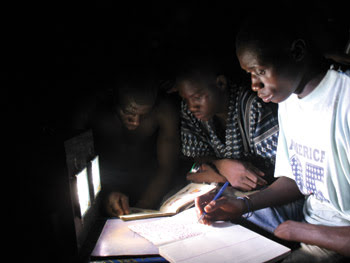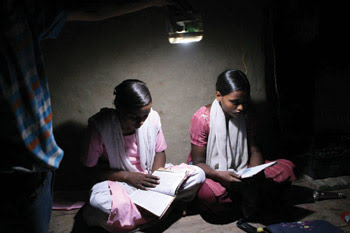Helping kids do their homework, lowering occurrence of lung disease, preventing fire hazards, opening up business opportunities and reducing the carbon footprint are only a few of the ways in which photonics technologies are at the heart of a social movement.
In India, sub-Saharan Africa and other underdeveloped areas of the world, interior lighting is provided by kerosene lanterns. The lighting is expensive and insufficient, and it poses a health and fire hazard. It also adds to global carbon emissions.
Several businesses and organizations are providing alternatives to kerosene lighting in developing nations. “Lighting Africa” is a World Bank Group initiative that aims to provide lighting not based on fossil fuel to the 250 million Africans in greatest need by the year 2030. At its Global Business Conference for Off-Grid Lighting held in Ghana in May, Lighting Africa announced its 16 competition winners, who will receive seed money for projects that bring lighting to rural parts of Africa. One recipient, Lights for Life International, based in Toronto, manufactures a portable light called the Nuru – meaning “light” in Swahili. The company’s mission is twofold: to help children study with proper lighting and to lower global carbon dioxide emissions by reducing the use of kerosene lamps.

LED lamps, shown here being used in Ghana, are powered by the sun and output about 75 lm up to nine hours a day. Photo courtesy of Light Up the World.
Illuminate illiteracy
The nonprofit organization Light Up the World, based in Calgary, Alberta, Canada, operates on the principle that inadequate lighting contributes directly to the cycle of illiteracy and poverty. Partnering with industry experts, nongovernmental organizations, local communities and the University of Calgary, Light Up the World has lit up the lives of more than 100,000 people in 44 countries. Its mission is to bring solar-powered solid-state lighting to the 1.6 billion people in the developing world who do not have access to electricity. The home lighting system it provides consists of two
, a 5-W solar panel and a charge controller. Each LED lamp contains a single white diode that can last for more than 50,000 hours. When set to their highest brightness, the lamps can output ~75 lm at the lens and draw an average of 1.8 W of power.
The 5-W solar panels are extremely durable and rated for ~80 percent of initial output after 20 years. The cables from the solar panel plug directly into the charge controller, which regulates the system and cuts off the current if the battery voltage drops to 12 V and permits the lights to operate again only after the panel has brought the battery voltage to 12.4 V. This regulation prolongs battery life and ensures that the system functions at its maximum capacity. The only part of the system that requires regular replacement is the battery. Based on the system’s design, the battery may last, on average, for two years if fully discharged every day. When fully charged, the system can provide up to nine lamp hours per day on full brightness (4.5 hours per lamp) or up to 28 lamp hours of light using the dim function. These estimates are based on 4.8 peak sun hours.
The company d.light design, headquartered on Grand Cayman Island, has a similar mission. It is the brainchild of two Stanford business school grads and aims to replace all kerosene lighting throughout the world by 2017. One of the founders, chief executive officer Sam Goldman, says the company estimates that there are 1.6 billion people throughout the world who do not have regular access to electricity.
The d.light lamps come in different designs – some use LEDs, and others use compact fluorescent bulbs. They’re battery-powered and charged with AC (for those with access) or with a small portable solar panel. The lights run for up to 32 hours on a charge and are priced from $12 to $30. This is expensive for families in rural India, but with the rising cost of kerosene, the lights are selling fast. D.light also has set up the “Give Light” program, whereby people can donate money to assist families in purchasing the lighting.

Portable LED lamps provide lighting for schoolgirls in India. Photo courtesy of d.light.
John Barrie Associates of Ann Arbor, Mich., also is providing lighting to rural areas. An architectural firm specializing in sustainable designs, the company developed a rechargeable light called Gaialux, which consists of a 10-W solar panel and two LED light fixtures rated at 2 W each. Upon touring Guatemala, where lighting like this is in great demand, the company learned that nearly everyone has a cell phone but, because many residents were living without electricity, they had no way to keep the phones charged. So the Gaialux design features an outlet that can be used to charge a cell phone or to run a radio or other small electronic devices.
Bring solar home
In addition to portable lighting, small-fixture solar lighting systems also are becoming available to people in developing nations. The United Nations Environment program, for example, has partnered with banks to offer affordable loans for solar home systems. Through the U.N.’s Indian Solar Loan program, more than 20,000 lighting systems have been installed in rural India, benefiting more than 100,000 people. The solar home systems typically include a roof-mounted photovoltaic panel, a storage battery and controller, and interior lighting fixtures with up to four compact fluorescent lights.
Low-energy lighting systems, whether portable or permanent, offer benefits far beyond replacing hazardous kerosene lanterns with technology that requires no fossil fuel. It’s exciting to think that these photonics technologies are helping to light up places that previously had little or no light at all. Solar-powered solid-state lighting, which can be installed anywhere, has opened up a new way of life in rural areas where grid power is unreliable or unavailable. Implementing nonfossil-fuel-based lighting throughout the world will move us all a little farther off the grid and closer to a carbon-neutral world.